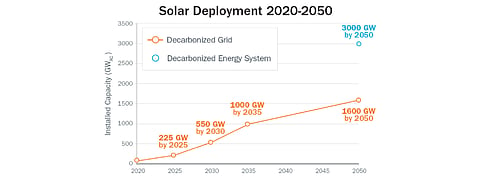

The US Department Of Energy (DOE) believes there is a potential for solar energy to account for 40% of the country's electricity mix by 2035, while creating jobs for around 1.5 million, without raising electricity prices and ensuring 95% decarbonization of the grid. By 2050, solar could account for 45% of the electricity mix.
According to a Solar Futures Study released by the DOE, the country needs to install an average of 30 GW AC of solar capacity annually between now and 2025, growing to annual additions of 60 GW AC from 2025 to 2030 to a total of between 760 GW AC to 1,000 GW AC capacity by 2035. By 2050, it should reach 1,050 GW AC to 1,570 GW AC to achieve a zero-carbon grid with enhanced electrification of end uses as motor vehicles and building space and water heating.
"Preliminary modeling shows that decarbonizing the entire U.S. energy system could result in as much as 3,200 GW AC of solar due to increased electrification of buildings, transportation, and industrial energy and production of clean fuels," reads the study.
Land wouldn't be a constraint for solar capacity to grow since by 2050 the study analysts see ground mounted solar requiring a maximum of 0.5% equivalent of continuous surface area. The remaining capacity deployment can be done in the form of distributed or contaminated land that's not suitable to be used otherwise.
From the remaining energy mix, 36% will come from wind, 11% to 13% from nuclear, 5% to 6% from hydroelectric and 1% of biopower/geothermal.
To support more flexibility and resilience of the grid, the study suggests storage deployment to grow from 30 GW to nearly 400 GW in 2035 and 1,700 GW in 2050. Focus will also need to be paid to advanced tools as grid-forming inverters, forecasting and microgrids.
To enable the deployment of solar at such a large scale, the study touches upon the availability of enough material supplies for solar PV technology saying this 'likely' will not limit solar growth in the decarbonization scenarios 'especially if end-of-life materials displace use of virgin materials via circular-economy strategies'.
"Developing the U.S. PV supply chain could mitigate challenges related to production disruptions, competing demand from other industries or countries, and global politics. However, lower labor costs and weaker environmental regulations outside the United States create challenges in matching costs from other countries," according to the authors, and for this policy support will be helpful.
Notably, as the US government has begun to limit the import of solar modules with expected use of polysilicon originated from Xinjiang, analysts fear delay in solar project commissioning, a problem that is likely to grow in the near future till the supply chain diverts from dependence on China (see Sign Of Times To Come? US Govt. Detaining PV Modules).
The report is available on the website of the DOE.
Welcoming the study findings, the California Solar+Storage Association (CALSSA) Executive Director Bernadette Del Chiaro said there needs to be a focus on rooftop solar too as that would help transition to 100% clean energy less expensive for ratepayers while helping conserve open space.
President and CEO of the American Council on Renewable Energy, Gregory Wetstone said, "A key step to achieving this critical objective is the reform of the nation's tax code now pending in Congress. We must move the renewable sector beyond the endless cycle of temporary stopgap measures to a stable, predictable and long-term clean energy tax platform that helps decarbonize the economy while putting millions of Americans back to work."
.png?w=50&fm=png)